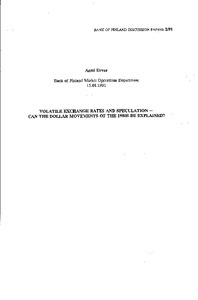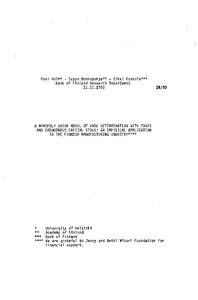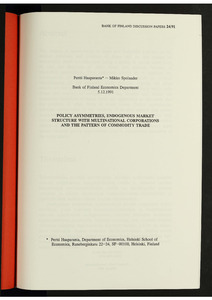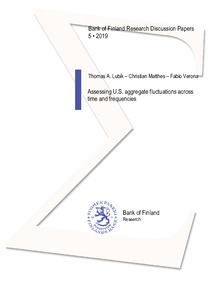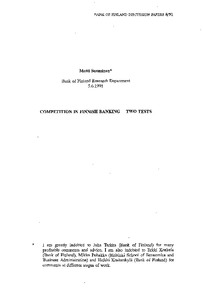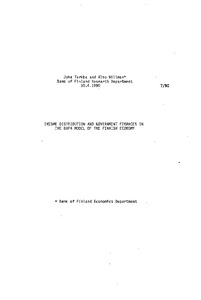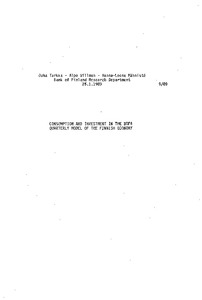Haku
Viitteet 1-10 / 48
Volatile exchange rates and speculation : can the dollar movements of the 1980s be explained?
(15.01.1991)
Bank of Finland Research Discussion Papers 2/1991
Bank of Finland Research Discussion Papers 2/1991
The paper analyzes why exchange rates can deviate substantially from levels predicted by economic fundamentals. Chapter 2 reviews traditional exhange rate models and shows how they fail. Since speculation seems to·play a ...
Bankruptcies and aggregate economic fluctuations
(10.09.1992)
Bank of Finland Research Discussion Papers 25/1992
Bank of Finland Research Discussion Papers 25/1992
This paper explores the determinants of aggregate economic fluctuations in Finland. The analysis makes use of aggregate monthly time series for some financial and non-financial variables. covering the period 1922-1990. In ...
A monopoly union model of wage determination with taxes and endogenous capital stock : an empirical application to the finnish manufacturing industry
(21.11.1990)
Bank of Finland Research Discussion Papers 24/1990
Bank of Finland Research Discussion Papers 24/1990
The paper formulates a model of wage determination in accordance with the notion of a monopoly union determining wages after which the firm decides on employment. The novelty is to incorporate investment and capital decisions ...
Policy asymmetries, endogenous market structure with multinational corporations and the pattern of commodity trade
(22.11.1991)
Bank of Finland Research Discussion Papers 24/1991
Bank of Finland Research Discussion Papers 24/1991
The impact of asymmetries in trade and industrial policies on the market structure and location of firms and on the pattern of commodity trade are examined using a model in which firms have to take the decisions of other ...
Assessing U.S. aggregate fluctuations across time and frequencies
(20.02.2019)
Bank of Finland Research Discussion Papers 5/2019
Bank of Finland Research Discussion Papers 5/2019
We study the behavior of key macroeconomic variables in the time and frequency domain. For this purpose, we decompose U.S. time series into various frequency components. This allows us to identify a set of stylized facts: ...
Estimating conditional betas and the price of risk for a thin stock market
(16.03.1992)
Bank of Finland Research Discussion Papers 8/1992
Bank of Finland Research Discussion Papers 8/1992
This paper examines the Sharpe-Lintner Capital Asset Pricing Model (CAPM) in which time-varying-parameter models are altemative to the static market model. Prior evidence does not support the CAPM and suggests that market ...
Competition in Finnish banking : Two tests
(05.06.1991)
Bank of Finland Research Discussion Papers 8/1991
Bank of Finland Research Discussion Papers 8/1991
This paper extends Bresnahan's (1982) test of competition to the two-product case. Applying this extension, as well as Bresnahan's original one-product test to the Finnish banking industry before and after the deregulation ...
Income distribution and government finances in the BOF4 model of the Finnish economy
(30.04.1990)
Bank of Finland Research Discussion Papers 7/1990
Bank of Finland Research Discussion Papers 7/1990
This paper describes how income distribution and government finances are modelled i n BOF4, a quarterly econometric model of the Bank of Finland. The equations eomprising the ineome distribution and government finanees ...
International capital flows, deregulation and the offset coefficient in Finland 1975-1990
(16.05.1991)
Bank of Finland Research Discussion Papers 7/1991
Bank of Finland Research Discussion Papers 7/1991
This study examines, using variable-parameter regression, how the offset coefficient in the capital flow equation for Finland has changed over time. We found the constant parameter estimate of the offset coefficient to be ...
Consumption and investment in the BOF4 quarterly model of the Finnish economy
(25.01.1989)
Bank of Finland Research Discussion Papers 9/1989
Bank of Finland Research Discussion Papers 9/1989
This report describes the determination of private consumption and investment in the BOF4 model. The consumption function of the model is largely based on thepermanent income hypothesis. Relative prices and the level of ...
